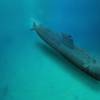The Navy is moving ahead with plans to build a 500-square-mile sonar training range off the coast of North Carolina, officials said, a project that has sparked fierce opposition from environmentalists who say some of the world's most endangered whales and sea turtles pass through the area, according to a report on www.boston.com
Planning for the $99 million range has been underway for almost 10 years, but environmental challenges and concern that the sound waves from sonar may harm protected marine mammals have held up the process. The Navy published its draft environmental impact statement Oct. 21 and will begin a series of public hearings on the proposal next month.
The proposed site, about 50 miles off North Carolina, was selected to provide the Atlantic fleet with training in the use of sonar in coastal areas, where the Navy believes the greatest submarine threats now exist. The global spread of quiet and relatively low-cost diesel submarines has alarmed the Navy and convinced officials that its sailors need more training in detecting hostile subs in areas closer to shore.
But marine mammal researchers and environmentalists have grown increasingly alarmed over the Navy's plans and the potentially damaging effects of active sonar -- which sends out loud blasts of underwater sound.
Whales and other marine mammals have very sensitive hearing, and research has shown that sonar can disorient and sometimes kill them. The Natural Resources Defense Council, an environmentalist group, sued the Navy earlier this month over its use of mid-frequency sonar, the type that would be deployed at the new sonar range. The group asserted that the sonar threatened endangered animals, in violation of several federal environmental laws.
Marine mammal advocates say they see the proposal for an East Coast sonar range as a long-feared ''test case" of increased Navy assertiveness -- especially since one of the most endangered and highly protected whales on the planet migrates through the region.
The world's 300 to 350 remaining North Atlantic right whales, whose numbers were decimated in the 1800s by whalers who considered it the ''right" one to harpoon, are known to travel from the Arctic to Florida along the East Coast. Their plight led this year to federal regulations requiring Navy and commercial vessels to take a variety of steps to avoid them.
Asked why the right whale was not mentioned as a potential problem at the North Carolina site, a US Fleet Forces Command spokesman said the majority of right whale sightings there are within 37 miles of shore. Because the training range would be 50 miles offshore, the environmental impact statement concludes the right whale is ''expected to occur only rarely in the vicinity of the proposed site."
In its draft statement, the Navy presented both its reasons for building the range and its assessment of the environmental risk. The primary need, the statement said, is to train sailors in the proper use of sonar.
The Navy said after an exhaustive review, it concluded that ''the overwhelming majority" of noise would be in the ''non-injurious" range. Overall, it concluded, sonar noise would have a ''negligible impact" on marine mammals and new precautions could further limit any potential risks.
Adding to the controversy, the proposed North Carolina site is in the vicinity of a mass whale stranding that occurred in January, when 37 whales from three species died on the beach within 24 hours. The Navy was conducting a sonar training exercise offshore during that time, but Navy officials say the ships were too far away to have caused the strandings.
A National Oceanographic and Atmospheric Administration investigation of the stranding was to have been issued this summer, but officials now say it will not be ready until early next year, after the comment period for the sonar training range has closed.
Featured videos

Send in the Drones (to deep, dark, confined maritime spaces)

Taking the First Step Toward Autonomy
October 2024
 Read the Magazine
Read the Magazine

 Read the Magazine
Read the Magazine
This issue sponsored by:

One-on-One: Ben Palmer, President, Inmarsat Maritime
Subscribe for
Maritime Reporter E-News
Maritime Reporter E-News is the maritime industry's largest circulation and most authoritative ENews Service, delivered to your Email five times per week









